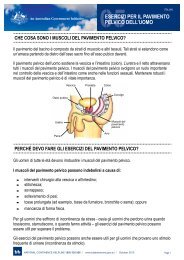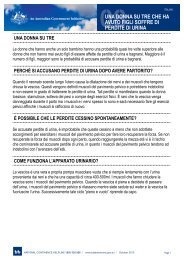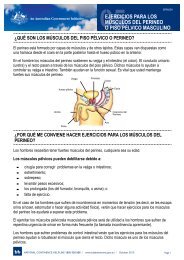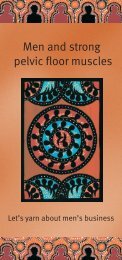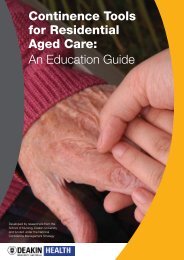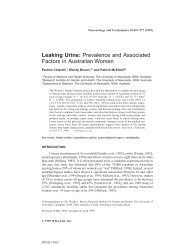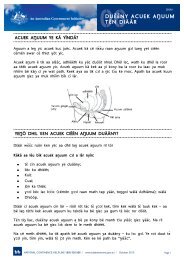Pharmacy Continence Care - Bladder and Bowel Website
Pharmacy Continence Care - Bladder and Bowel Website
Pharmacy Continence Care - Bladder and Bowel Website
You also want an ePaper? Increase the reach of your titles
YUMPU automatically turns print PDFs into web optimized ePapers that Google loves.
• location<br />
• respondent type<br />
• pharmacy size. 0000147A five point rating scale was used for each question: 5=Very<br />
high level, 4=High level, 3=Moderate level, 2=Low level, <strong>and</strong> 1=Very low level.<br />
The following is a summary of the analysis.<br />
Differences in satisfaction level linked to training type<br />
The analysis of training satisfaction rating indicated there was no significant difference in the<br />
satisfaction level with the overall Program according to the type of training. Figure 23 shows<br />
the levels of satisfaction by training mode. All the average scores are in the range of “High”<br />
level of satisfaction. This is interesting given that the majority of pharmacies originally<br />
indicated a preference for face-to-face training at their own site.<br />
Average rating (on scale 1-5)<br />
4.25<br />
4.2<br />
4.15<br />
4.1<br />
4.05<br />
4<br />
3.95<br />
3.9<br />
Average Satisfaction Rating<br />
face-to-face telephone self-paced face-to-face at<br />
another site<br />
Figure 23: Average satisfaction rating<br />
Type of Training<br />
Differences in results according to location<br />
Participating pharmacies were from all jurisdictions <strong>and</strong> responses to the PIQ/PEQ were also<br />
received from all states <strong>and</strong> territories. Pharmacies were classified by five areas –<br />
metropolitan, outer metropo8tan, regional, rural <strong>and</strong> remote – <strong>and</strong> responses were examined<br />
for any differences in level of satisfaction according to degree of rurality.<br />
There was a significant difference in satisfaction with the Program based on the degree of<br />
rurality of the pharmacy: metropolitan pharmacies were more likely to express satisfaction<br />
than regional pharmacies, independent of the type of training that was delivered. Regional<br />
pharmacies were also less likely to indicate that their expectations had been met by the<br />
Program <strong>and</strong> rated the usefulness of the Program lower than the other groups (see Figure<br />
24). Once again the level of satisfaction expressed by all groups was high, even for the<br />
regional area.<br />
Final Report<br />
29<br />
NOVA Public Policy<br />
<strong>Pharmacy</strong> <strong>Continence</strong> <strong>Care</strong> Project



